8-Hour Workday: What You Need to Know (+ Calculators)
Calculate your work hours using 8-hour and 7.5-hour workday calculators.
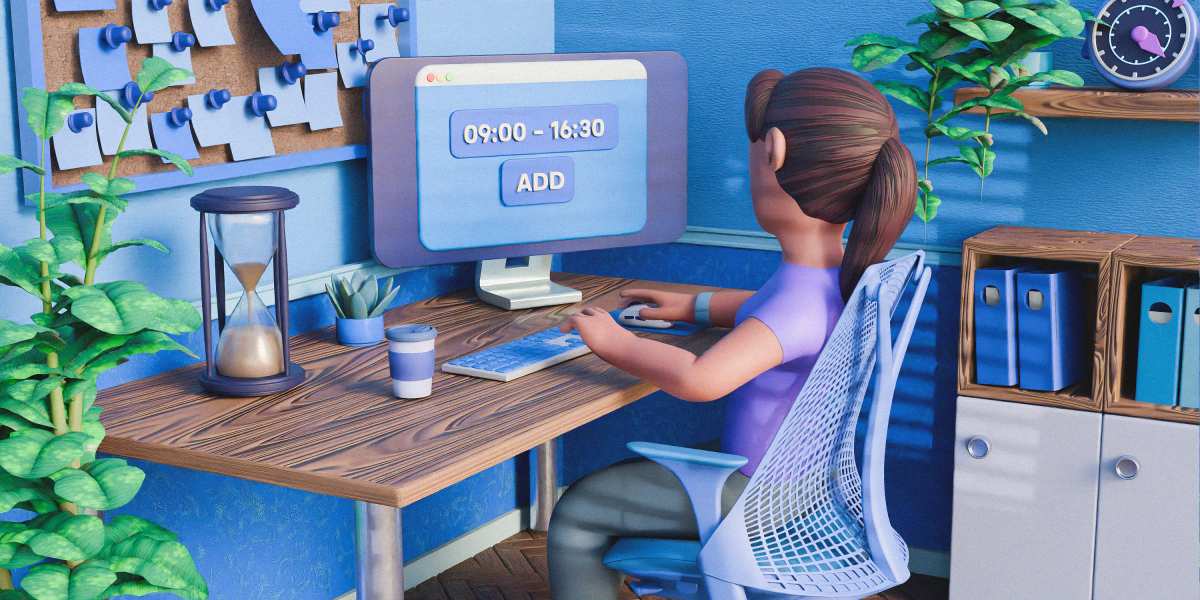
8-hour workdays became the global norm a while ago. But have you ever wondered how did we get an 8-hour workday? Today, we’re bringing you the history of working 9-5 and how it became normal for employees to work 8 hours a day. Moreover, we’ve created 8-hour and 7.5-hour workday calculators to help you avoid overworking and make sure you work precisely 8 hours and not a minute more!
KEY TAKEAWAYS:
- Robert Owen is believed to have come up with the 8-hour workday concept.
- Ford Motor is the first manufacturing company to introduce an 8-hour workday in the US.
- Workday calculator can help you determine the exact time you need to end your workday.
- You can make the most of your 8-hour workdays by planning your daily tasks in advance.
- Research shows that working longer hours affects your mental and physical health.
What is an 8-hour workday?
An 8-hour workday is a standardized workday during which employees work 8 hours per day. They typically work 8-hour shifts for 5 days in a row, up to a total of 40 hours per week.
While working 9-5 is considered the usual working time in the US, an 8-hour workday doesn’t depend on the time you start working. Employees could work morning, evening, or night shifts as long as their hours worked don’t exceed 8 hours.
🎓 How to Make an 8-Hour Workday Schedule Work
A history of the 8-hour workday
If you were wondering who invented the 8-hour workday and how a 40-hour week became the norm for full-time employees, this section has the answers.
In addition, you’ll learn how working hours could change in the future.
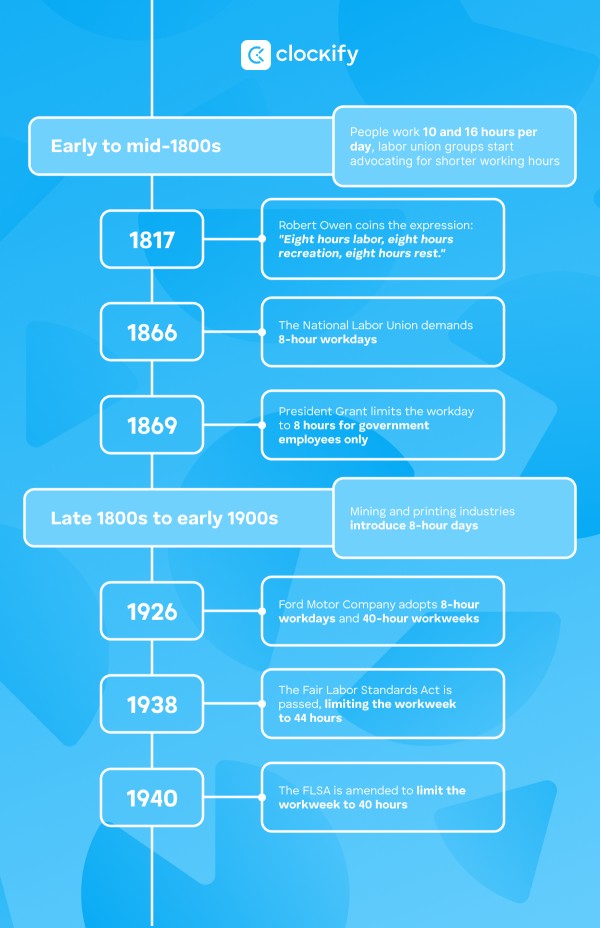
Early to mid-1800s: People work 10 and 16 hours per day, 6 days a week
Until the mid-1800s, a typical worker in the manufacturing industry was required to work between 10 and 16 hours per day and have 6 working days a week. This translates to employees working nearly 100 hours per week.
The impact of such long hours affected both the physical and mental health of workers, as work-life balance was practically non-existent.
The 8-hour shift movement started in the early 1800s. A social reformer Robert Owen came up with the expression: "Eight hours labor, eight hours recreation, eight hours rest."He is believed to be the inventor of the 8-hour workday.
1866–1938: The 8-hour workday movement
After the Industrial Revolution, labor unions started advocating for change regarding the weekly hours of work.
In 1866, the National Labor Union mandated that Congress pass a law limiting the workday to 8 hours. In 1869, President Ulysses S. Grant issued an 8-hour workday proclamation that promised 8-hour workdays to government employees only.
At the end of the 1800s and in the early 1900s, many industries, including mining and printing, introduced 8-hour days.
The Labor Union’s efforts finally came to fruition in 1938 when the Fair Labor Standards Act was passed. At first, the Act limited the workweek to 44 hours. But, in 1940, the FLSA was amended to limit the workweek to 40 hours.
1926: Henry Ford's revolutionary role in an 8-hour workday and 5-day workweek
In 1926, the Ford Motor Company became one of the first in the US to adopt a 5-day, 40-hour workweek.
This move significantly increased productivity, employee engagement, and loyalty. Henry Ford thus became one of the revolutionaries in the 40-hour workweek movement, setting the standard for others to follow.

Aside from the 40-hour workweek, Ford also embraced the 9-to-5 working schedule. After him, many manufacturing facilities and factories also began working 9-5. Today, a 9-to-5 job is considered a norm for companies in nearly all industries.
What does the future look like for the 8-hour workday?
In recent years, employees have gone through major changes in the way they work. Remote and hybrid working arrangements became much more common. For many workers, this meant more work flexibility regarding both the place they work and their work hours.
According to a 2023 FlexJobs survey, 77% of workers feel more productive when working remotely. In addition, 93% feel remote work improved their mental health, while 90% believe it benefited their physical well-being.
As a result, this survey shows that 51% of employees prefer fully remote work, while 46% would like to have a hybrid working arrangement.
What’s more, a 4-day workweek became a topic of discussion after the major success of Iceland’s 4-day workweek trials. Yet, Iceland is not the only country boasting the great results of a 4-day workweek implementation. In fact, a 4-day week in Spain resulted in healthier workers and less pollution.
Moreover, a 2024 report by Autonomy on UK 4-day workweek trials shows that this arrangement proved beneficial even after years of its launch. Autonomy reported that 100% of CEOs and managers they consulted believe this arrangement had a positive impact on how their company operates. Furthermore, employees noted improvements in their physical and mental health, a better work-life balance, and overall life satisfaction.
While a 4-day workweek comes with organizational challenges, we are likely to see this arrangement becoming increasingly present in the future of work discussions.
How do you calculate 8-hour working days?
The 8-hour workday should end exactly 8 hours after an employee starts working. So, to calculate your 8-hour workday, write down the exact time your work began. Then, add 8 hours to this time to get the time your workday should end. You can use our working time calculator to get the exact time you should finish your work.
⏬ 8-hour working time calculator
To start using the calculator, firstly, click on the calculator link and choose Make a copy. Then, simply enter the time you started working and the calculator does all the work for you. You can also add a.m. or p.m. or use the 24-hour format to specify the time your work began.

How do you calculate an 8-hour workday with breaks?
Breaks in an 8-hour day depend on:
- Federal law,
- State regulations, and
- Company-specific rules and guidelines.
Short breaks lasting between 5 and 20 minutes are not required by federal law. However, if a company policy allows these short breaks, that period counts as compensable (included in the total sum of hours worked).
On the other hand, meal periods, which usually last 30 minutes, don’t count as time spent working. Thus, they aren’t compensable.
As break regulations vary by state, make sure to check state laws before calculating employees' working hours and breaks.
If you have to deduct a 30-minute break from your day, you can try our 7.5-hour working time calculator. It works the same as our 8-hour calculator.
⏬ 7.5-hour working time calculator
Once you click on the link and choose the Make a copy option, you should enter the start time of your work. The calculator will then determine the time at which your workday should end.
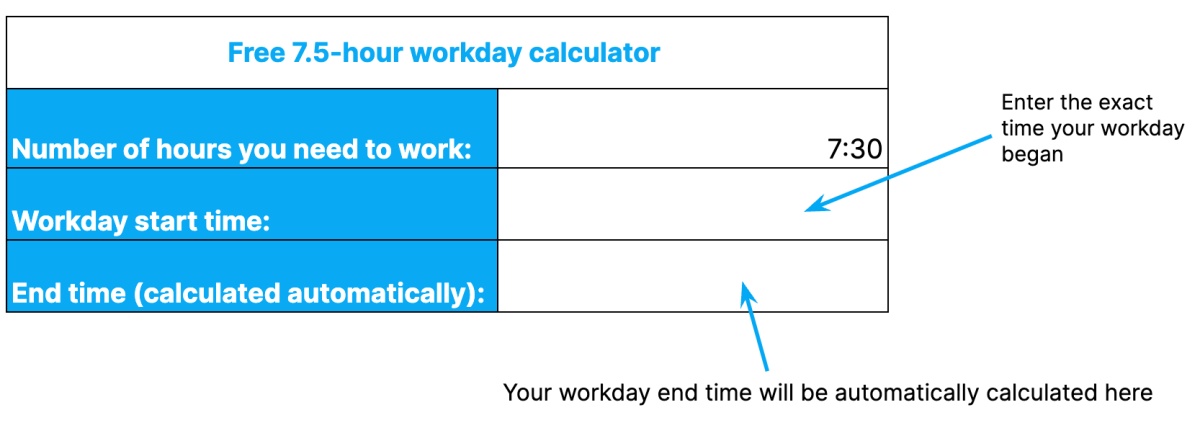
We also created a calculator that accounts for a 30-minute break. You can use it to determine the exact time your 7.5-hour shift, which includes a 30-minute break, ends.
⏬ 7.5-hour working time calculator with a 30-min break
After clicking on the link that leads you to the calculator, choose Make a copy. You can then edit the sheet.
We’ve already added the 7.5-hour workday and accounted for your 30-minute break. So, you only need to add your workday start time, and the calculator will give you the exact time your shift should end.
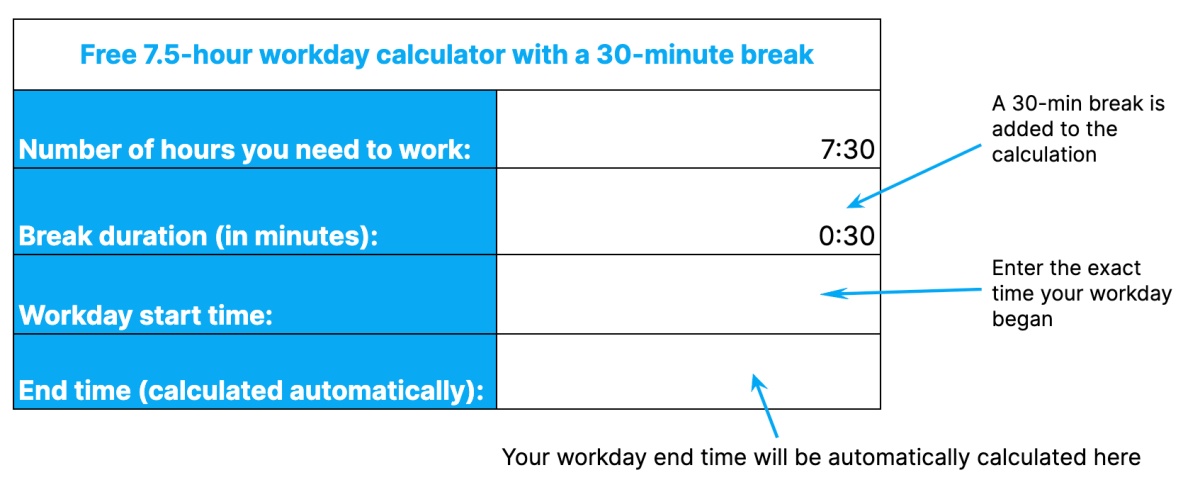
If you're working 8-hour shifts, what compensation are you entitled to?
The Fair Labor Standards Act sets the ground rules for two crucial aspects of work compensation: minimum wage and overtime pay.
On a federal level, the minimum wage currently sits at $7.25 for FLSA-covered employees. However, states have different minimum wages as the cost of living varies across the US. Thus, check out the state minimum wage laws to determine what you’re entitled to.
FLSA non-exempt workers whose shifts are longer than 8 hours or who have worked more than 40 hours per week receive overtime compensation. Exempt employees aren’t entitled to overtime pay. The minimum overtime rate is 1.5 times a worker’s regular hourly rate. Depending on state laws and regulations, the overtime rate can be higher.
What are the benefits of an 8-hour workday?
Benefits of a consistent 8-hour workday in a 5-day workweek include:
- Less stressful workday due to a consistent 8-hour schedule,
- Predictability in the hours worked each day which leads to easier work organization, and less procrastination,
- Less chance of overworking as 8 hours is the norm, and
- Simplified salary calculation process as most salaried positions consist of 8-hour working days.
What are the disadvantages of an 8-hour workday?
As this number of hours doesn’t work for everyone, the 8-hour workday can come with several downsides, such as:
- Reduced employee satisfaction, as a rigid 8-hour schedule won’t suit workers whose biological prime time happens outside working hours,
- Lack of motivation for employees who manage to complete their daily tasks before their workday is over,
- No overtime pay, as workers are paid for overtime when the number of hours worked is above 8 hours, and
- Fewer days off and more time spent commuting, as working no more than 8 hours a day means you reach the 40-hour workweek norm in 5 days, which leaves you with only 2 days off.
How to organize your 8-hour workday to be most productive?
The key to a productive workday is proper organization. Take a look at some expert tips on organizing an 8-hour workday.
Tip #1: Plan your workday
Your daily productivity depends on how effectively you plan your tasks. Founder of Teach.io, James Watts, notes that planning ensures you stay motivated:
“Planning your day either the night before or in the morning can help you stay motivated and focused, so you're not struggling with what to prioritize during your workday. Ensure you invest time in high-value tasks.”
🎓 How to plan your day and stay organized
A great way to plan your day is by creating to-do lists. CMO and co-founder of Radical Storage, Giacomo Piva, explains that short-term goals and defining priorities are crucial for creating to-do lists:
“Define priorities and create a to-do list with daily or at most weekly tasks/goals. I’ve learned that focusing on what I can accomplish in the short term is way more efficient than planning for the month.”
On the topic of prioritizing, Burnout Coach and Self-Care Strategist Daniela Wolfe suggests the Eisenhower matrix:
“Tools like the Eisenhower matrix are great at helping you prioritize — separating what's urgent and important, what's not urgent and not important, and everything in between.”
🎓 How to make a breakdown of your workday (with templates)
Tip #2: Take breaks to stay productive
A time management and productivity coach, Alexis Haselberger, believes we should take a break every time we feel we’re losing focus:
“When you feel yourself starting to fidget, starting to feel unfocused, take a break. Instead of fighting yourself, listen to your mind and body and go for a walk around the block, to the kitchen for a glass of water, or just read a few pages, listen to a short podcast, or even scroll social media for 10 minutes.”
🎓 How to Stay Focused When Working on a Computer
CMO of FloridaPanhandle.com, Brittany Betts, takes regular breaks to avoid burnout:
“Once I finish my easier tasks and my afternoon tasks, I give myself a 10-minute break to regroup. This break ensures that I avoid burnout, and also that I return to my work feeling inspired and productive. During this time, I will talk to my peers in the shared office space and hopefully get some creative juices flowing.”
Piva takes breaks after every hour of work:
“When I don’t have to solve urgent queries or get stacked in long calls, I usually work for about 1 hour and then take a short break (about 10-15 minutes). By taking a break I mean staying away from any kind of screen and doing something I enjoy.”
Tip #3: Remove distractions
Removing distractions is one of the best ways to stay focused at work. Watts recommends shifting your work setup:
“Standing desks or a pilates ball can make a difference in how you focus. And a bit of background noise. Listen to white or brown noise to drown out distractions. Lighting can also help you stay focused. Ensure your workspace is bright enough to keep you going without straining your eyes.”
🎓 Effects of Workplace Distractions in 2023: Crucial Statistics
Tip #4: Find your own rhythm
Try out different techniques and track your time to see when you’re most productive. Then, create a schedule around your productive hours.
Haselberger believes the best way to make the most of your day is to listen to your own body and mind:
“There's no "right" schedule. So spend a few days tracking when you get your best work done, when you're lethargic, when you're most focused, when you're most creative. Then build a rough schedule around that. It's much easier to work with who you are than to say, force yourself to get up and be creative early in the morning because you've heard it's a good thing to do, if you're actually a night owl.”
🎓 Personal productivity guide: Maximize productivity with these methods and apps
Tip #5: Reflect on your day
Watts believes that a workday retrospective helps us better prepare for our next workday:
“Spend a few minutes at the end of your workday looking back at what you’ve accomplished and what you need to tackle tomorrow. It’s a great way to check out for the day and prepare for the next.”
The consequences of employees working longer than an 8-hour shift
Various studies have shown that working long hours seriously impacts employees’ physical and mental health.
The National Library of Medicine published a meta-analysis on the effects of long working hours on employees. The analysis highlighted various older studies that showed the consequences of long working hours, including:
- Chronic fatigue,
- Stress,
- Depression,
- Anxiety,
- Poor sleep quality,
- Hypertension,
- Poor mental health, and
- A higher risk of cardiovascular diseases.
In addition, the study concluded that employees who work long hours are more likely to suffer from:
- Sleep disturbance and other sleeping issues,
- Work-related injuries, and
- Fatigue.
Moreover, a study on long working hours in Europe found that working more than 55 hours a week is associated with a variety of health issues, such as:
- Infections,
- Musculoskeletal disorders,
- Diabetes, and
- Injuries.
Furthermore, a study on long working hours in China showed a correlation between overworking and occupational stress, well-being, and depression.
Thus, even though we live in a culture that praises workaholism, employers should refrain from asking employees to work long hours as much as possible. Such expectations can lead to career burnout as well as serious issues that affect workers’ well-being.
🎓 How to Improve the Quality of Work Life?
How to track an 8-hour work day with Clockify
You now understand how the 8-hour workday works and why it’s important to avoid working long hours. But how to make sure you’re not overworking? We recommend keeping track of your work hours using time tracking software.
Clockify is a free work hours tracker that allows you to:
- Track every hour of work,
- Input breaks,
- Track overtime hours,
- Assign work tasks to different projects,
- Keep track of project progress,
- Manage multiple projects and tasks, and
- Get reports on hours worked during specific periods.
Clockify lets you track the time you spend on work activities using a timer. You can start the timer once you begin a task and stop it once you finish or need a break. Then, restart the timer for that task when your break is over, or add a new task and start the timer. Immediately after, you’ll see the total number of hours you worked that day so you’ll know when it’s time to end your workday.
Alternatively, you can manually enter your workday activities and the time you spent on each one after your workday ends.
In addition, the Clockify Dashboard provides an overview of time tracked during a specific period you entered. You can use it to review your working habits and ensure you consistently work eight hours during the week.
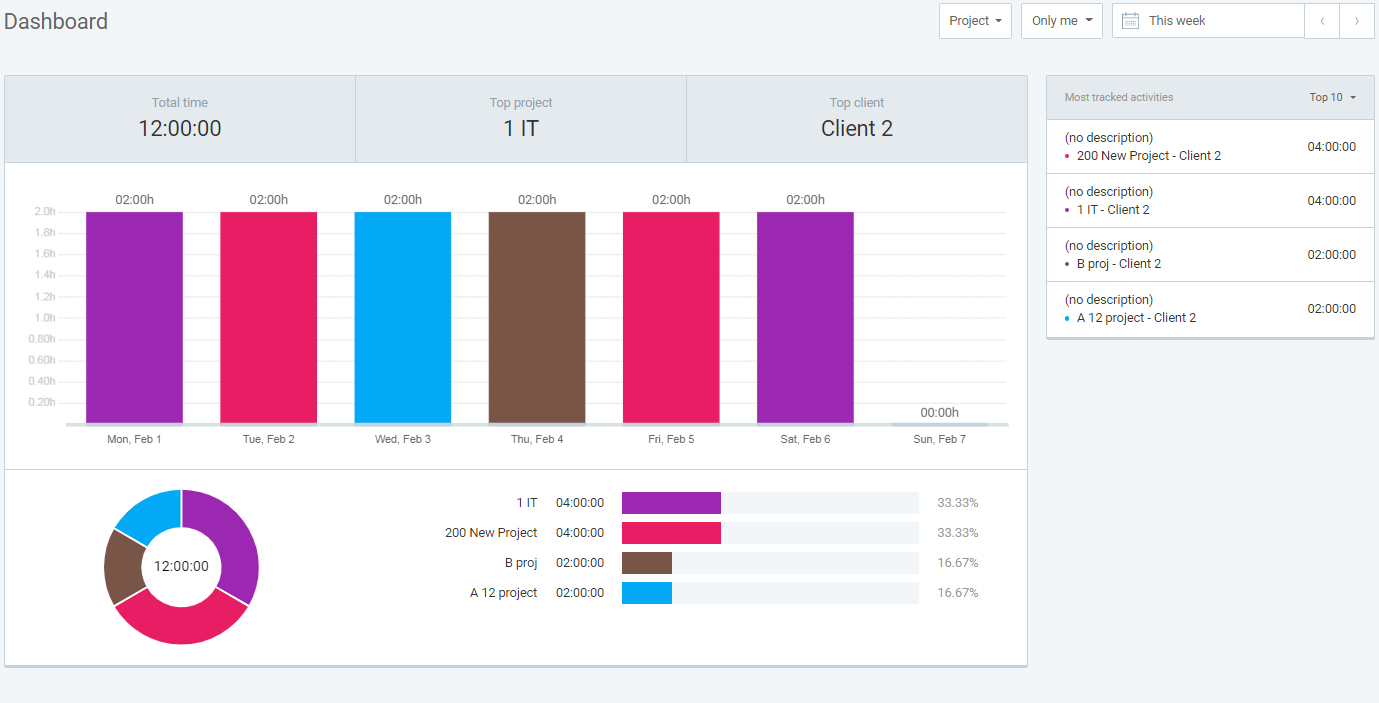
Sources
- Bauer, S. Maylander, A. (1919). The Road to the Eight-Hour Day. Monthly Labor Review
- Breaks and Meal Periods. US Department of Labor
- Broom, D. (2023). Four-day work week trial in Spain leads to healthier workers, less pollution. World Economic Forum
- Chan, A. Ngan, S.C. Wong, K. (2019). The Effect of Long Working Hours and Overtime on Occupational Health: A Meta-Analysis of Evidence from 1998 to 2018. Int J Environ Res Public Health
- Coverage Under the Fair Labor Standards Act. (2009). US Department of Labor
- Ervasti, J et al. (2021). Long working hours and risk of 50 health conditions and mortality outcomes: a multicohort study in four European countries. The Lancet Regional Health - Europe
- Founding of the National Labor Union and the 1st National Call for a 8-Hour Work Day. Library of Congress
- Four-day week 'an overwhelming success' in Iceland. (2021). BBC
- Grant, S. U. (1869).Proclamation 182. The American Presidency Project
- Hong, Y et al. (2022). The Influence of Long Working Hours, Occupational Stress, and Well-Being on Depression Among Couriers in Zhejiang, China. Front. Psychol.
- Hours Worked Under the Fair Labor Standards Act. (2008). US Department of Labor
- Howington, J. (2023). Losing Talent to Return-to-Office Mandates: Insights From the FlexJobs Survey. FlexJobs
- Making It Stick: The UK Four-Day Week Pilot One Year On. (2024). Autonomy
- Minimum Wage. US Department of Labor
- Onion, A. Sullivan, M. Mullen, M. Zapata, C. (2020). Ford factory workers get 40-hour week. History
- Overtime Pay. US Department of Labor
